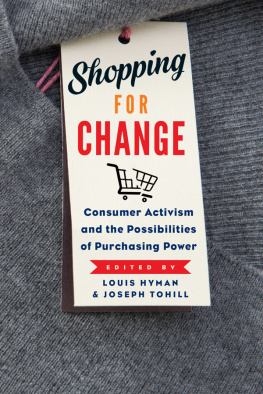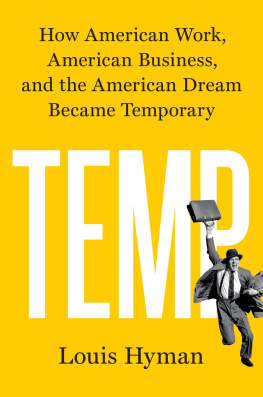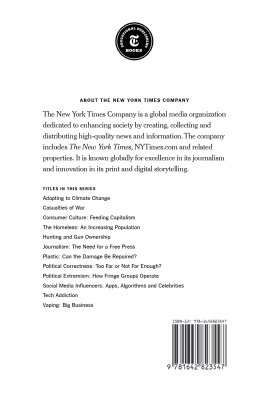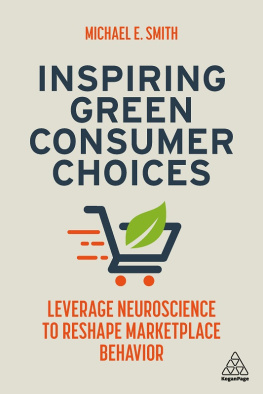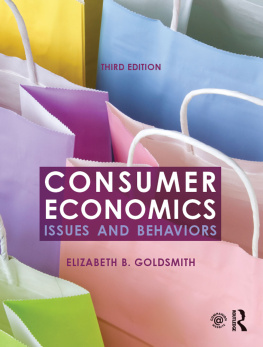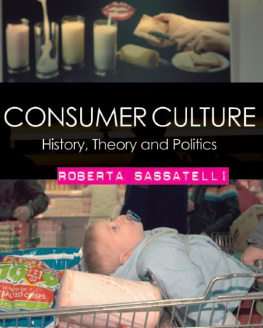Hyman and Tohill have produced a valuable collection, both wide-ranging and coherent, that belongs on the short shelf of essential histories of North American consumer cultures. By examining politicized consumption over two centuries and in the United States and Canada, by including studies of local and national movements, by examining grassroots and legislative struggles, the contributors to this volume have given us an excellent framework for understanding continuities and ruptures in the nature of the politics of shopping. By paying special attention to inequality and class, the volume helps place two seemingly separate contemporary movementsOccupy Wall Street and consumer boycottinginto broad historical context and into productive dialogue with each other. This book will become a go-to resource for scholars and activists alike.
Lawrence Glickman, author of Buying Power: A History of Consumer Activism in America
Shopping for Change wrestles impressively with the possibilities and obstacles for consumer activism over time. This is important history, but it is also a compelling call to harness the full potential of the consumer marketplace to create a more equitable, democratic society.
Lizabeth Cohen, author of A Consumers Republic: The Politics of Mass Consumption in Postwar America
Is consumer activism a worthwhile endeavour? And, if so, how should it be pursued? The contributors to this volume grapple creatively with these, and many other, important questions. Hyman and Tohill have assembled a wonderful array of engaging and insightful essays that mine the distant and recent past to show us whats worked, what hasnt, and why.
Michael Dawson, Department of History, St. Thomas University
This book could not be more timely. We see in many nations a large number of people reacting badly to their inability to maintain a standard of living they believe they need. Smarter, more active, and more restrained buying is what is called for. This book provides an outstandingly detailed guide for how to proceed.
Amitai Etizoni, author of The New Normal
SHOPPING
FOR CHANGE
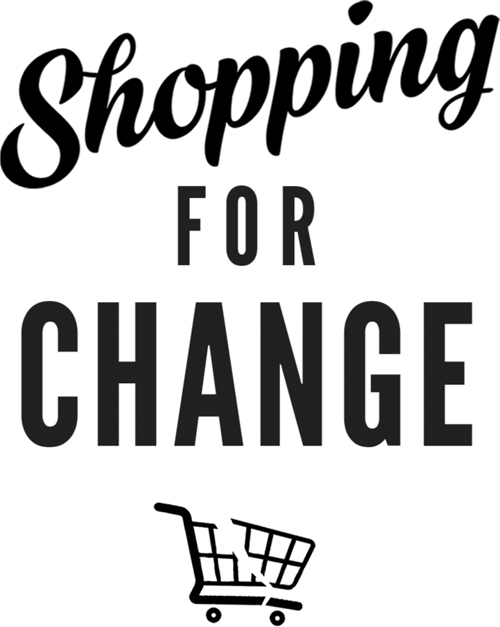
Consumer Activism and the
Possibilities of Purchasing Power
Edited by
Louis Hyman & Joseph Tohill
BETWEEN THE LINES
TORONTO
Shopping for Change
2017 Louis Hyman and Joseph Tohill
First published in 2017 by
Between the Lines
401 Richmond Street West
Studio 277
Toronto, Ontario M5V 3A8
Canada
1-800-718-7201
www.btlbooks.com
All rights reserved. No part of this publication may be photocopied, reproduced, stored in a retrieval system, or transmitted in any form or by any means, electronic, mechanical, recording, or otherwise, without the written permission of Between the Lines, or (for photocopying in Canada only) Access Copyright, 1 Yonge Street, Suite 1900, Toronto, Ontario, M5E 1E5.
Every reasonable effort has been made to identify copyright holders. Between the Lines would be pleased to have any errors or omissions brought to its attention.
Library and Archives Canada Cataloguing in Publication
Shopping for change: consumer activism and the possibilities of
purchasing power / editors, Louis Hyman, Joseph Tohill.
Includes bibliographical references and index.
Issued in print and electronic formats.
ISBN 978-1-77113-144-5 (paperback).ISBN 978-1-77113-145-2 (EPUB).
ISBN 978-1-77113-146-9 (PDF)
1. Consumer movementsCanada. 2. Consumer movementsUnited States. 3. Consumer movementsCanadaHistory. 4. Consumer movementsUnited StatesHistory. 5. Consumer behavior. 6. Consumption (Economics).
I. Hyman, Louis, 1977, editorII. Tohill, Joseph, editor
HC79.C6.S56 2017306.3C2016-907214-2
C2016-907215-0
Cover and text design by Gordon Robertson
Cover photo by Denis Mikheev
We acknowledge for their financial support of our publishing activities the Government of Canada through the Canada Book Fund, the Canada Council for the Arts, which last year invested $153 million to bring the arts to Canadians throughout the country, and the Government of Ontario through the Ontario Arts Council, the Ontario Book Publishers Tax Credit program, and the Ontario Media Development Corporation.

ACKNOWLEDGEMENTS
This volume would not have been possible without the vision of Amanda Crocker, Managing Editor at Between the Lines, whose confident stewardship saw it from inception to publication. We would like to thank the staff of both BTL and Cornell University Press, particularly Frances Benson.
Two anonymous peer reviewers of the volume contributed greatly to its improvement, as did our copy editor, Cameron Duder. Gordon Robertson is responsible for the excellent design.
The editors would also like to thank the contributors, whose hard work and patience finally paid off.
INTRODUCTION
Shopping for Change
LOUIS HYMAN and JOSEPH TOHILL
The great recession reminded us that while we are all part of the economy we do not share in that economy equally. If before 2008 the two numbers that represented capitalism were the GDP and the Dow, then after 2008, thanks to the Occupy Wall Street movement, those two numbers are now the 1 percent and the 99 percent. Occupy Wall Street did not stop Wall Streets excesses. Even now, years later, after the stock market has recovered and GDP growth has returned, inequality still haunts our debatesand our economy. Yet Occupy did change our views of what a successful and more equitable economy could look like. If the Occupy movement accomplished anything, it was to reawaken our sense that change was, and is, possible.
The language of Occupy originated with the academic work of the then-obscure economist Thomas Piketty, but it was academics and activists working together that made this key shift in our understanding of capitalism possible.social movements and activism from Strike Debt to Black Lives Matter, from the Fight for $15 and Fairness to Idle No More.
While we could easily think of shopping as disconnected from the rest of our economic lives, the freedom of choice we experience in stores is inextricably connected to the lack of choice in the workplace and, increasingly, in politics. Our contemporary understanding of economic inequalityalso known as class difference (something most North Americans like to pretend does not apply to them)is articulated less by our work than by our consumption. Class, in this post-recession world, is defined more by the power to consume than by the power to produce. Whether false consciousness or not, this experience of class as consumption fundamentally drives our politics today.
Every day we make decisions about how to spend our money, and, for the socially conscious, we want these decisions to matter. Consuming with a conscienceusing individual and collective purchasing power for political endsis among the fastest growing forms of political participation worldwide. The most common form of consumer activism, the boycott, involves collectively shunning goods and services produced or sold by particular firms, industries, nation-states, or (on occasion) ethnic groups. Another common activity is the buycott, through which activists encourage the consumption of particular goods or brands for moral, ethical, or political reasons. Such political consumerism (as political scientists label it) or consumer activism (historians preferred term) is premised on a belief that consumption is an inherently political act embedded in a complex web of economic and social relations. This belief establishes both a framework and a prescription for grassroots collective action that makes use of the buying power of consumers to change market, business, or government practices or policies that activists find politically, ethically, or environmentally unacceptable. Recognizing the connections between our consumer choices and other issueslabour rights, civil rights, corporate behaviour, the environment, and human rightsconsumer activists practise a form of long-distance solidarity that links them not only to like-minded consumers but also to distant workers, employers, environments, and nations. And so, political consumers, as contributors to this collection tell us, buy green for the environment or buy pink to combat breast cancer. They boycott Taco Bell to support migrant workers or Burger King to save the rainforest.
Next page
